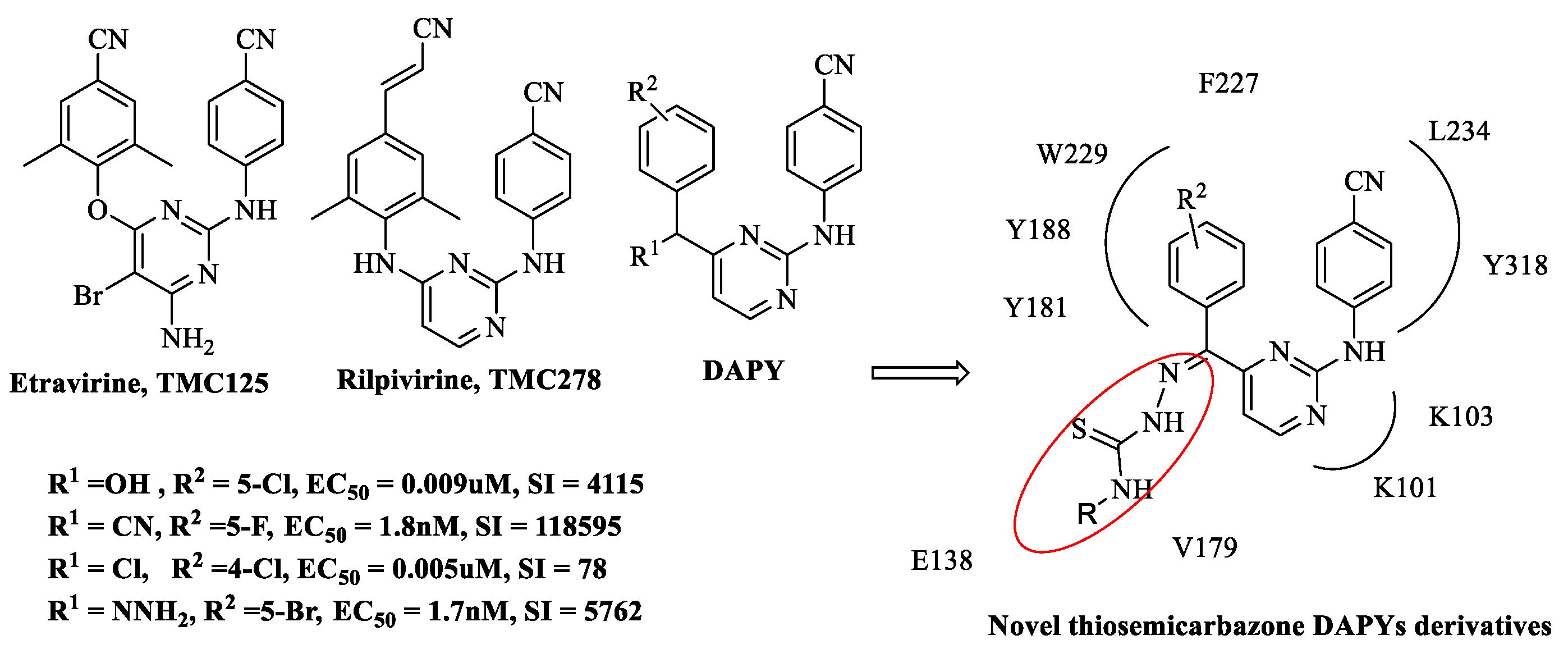Designing Novel Hydrazinecarbothioamides as Potential HIV-1 Non-Nucleoside Reverse Transcriptase Inhibitors †
Acknowledgments
Author Contributions
Conflicts of Interest
References
- Schafer, J.J.; Short, W.R. Rilpivirine, a novel non-nucleoside reverse transcriptase inhibitor for the management of HIV-1 infection: A systematic review. Antivir. Ther. 2012, 17, 1495–1502. [Google Scholar] [CrossRef] [PubMed]
- Ge, M.; Yang, L.; Aqun, Z.; Fener, C.; Chen, W.; de Clercq, E.; Pannecouque, C.; Balzarini, J. Design and synthesis of a new series of modified CH-diarylpyrimidines as drug-resistant HIV non-nucleoside reverse transcriptase inhibitors. Eur. J. Med. Chem. 2014, 82, 600–611. [Google Scholar]
- Meng, Q.; Chen, X.; Kang, D.; Huang, B.; Li, W.; Zhan, P.; Daelemans, D.; De Clercq, E.; Pannecouque, C.; Liu, X. Design, synthesis and evaluation of novel HIV-1 NNRTIs with dual structural conformations targeting the entrance channel of the NNRTI binding pocket. Eur. J. Med. Chem. 2016, 115, 53. [Google Scholar] [CrossRef] [PubMed]

Publisher’s Note: MDPI stays neutral with regard to jurisdictional claims in published maps and institutional affiliations. |
© 2017 by the authors. Licensee MDPI, Basel, Switzerland. This article is an open access article distributed under the terms and conditions of the Creative Commons Attribution (CC BY) license (https://creativecommons.org/licenses/by/4.0/).
Share and Cite
Yin, H.; Wan, Z.; Meng, G.; Chen, F.-E.; Clercq, E.D.; Pannecouque, A.C. Designing Novel Hydrazinecarbothioamides as Potential HIV-1 Non-Nucleoside Reverse Transcriptase Inhibitors. Proceedings 2017, 1, 274. https://doi.org/10.3390/proceedings1060274
Yin H, Wan Z, Meng G, Chen F-E, Clercq ED, Pannecouque AC. Designing Novel Hydrazinecarbothioamides as Potential HIV-1 Non-Nucleoside Reverse Transcriptase Inhibitors. Proceedings. 2017; 1(6):274. https://doi.org/10.3390/proceedings1060274
Chicago/Turabian StyleYin, Hong, Zhengyong Wan, Ge Meng, Fen-Er Chen, Erik De Clercq, and And Christophe Pannecouque. 2017. "Designing Novel Hydrazinecarbothioamides as Potential HIV-1 Non-Nucleoside Reverse Transcriptase Inhibitors" Proceedings 1, no. 6: 274. https://doi.org/10.3390/proceedings1060274
APA StyleYin, H., Wan, Z., Meng, G., Chen, F.-E., Clercq, E. D., & Pannecouque, A. C. (2017). Designing Novel Hydrazinecarbothioamides as Potential HIV-1 Non-Nucleoside Reverse Transcriptase Inhibitors. Proceedings, 1(6), 274. https://doi.org/10.3390/proceedings1060274





